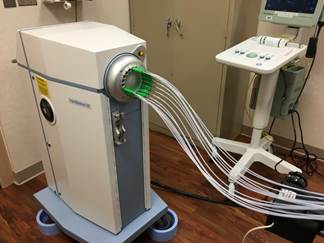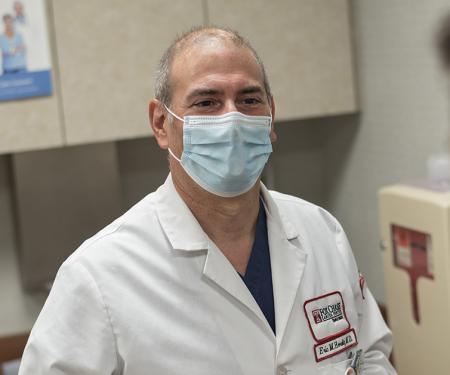New Inpatient Visitor Check-In Process Effective March 10. Learn more here.
Breadcrumb
Brachytherapy

Brachytherapy, a form of internal radiation therapy, uses radioactive seeds directly implanted in the cancer site, confining the radiation to the tumor and reducing radiation exposure to the surrounding healthy tissues. This type of treatment can be administered either as permanent low dose-rate (LDR) implant, or as temporary high dose-rate (HDR) implant. Because of its highly conformal targeting, it works best for low- to intermediate-risk cancers that have not spread beyond the prostate. It also can be combined with external beam radiation or hormonal therapy for more aggressive cancers.
Fox Chase was the first to perform HDR prostate implants in the Eastern United States and has one of the largest brachytherapy programs in the region. Fox Chase was also the first in the region to use real-time intraoperative brachytherapy planning. This technique allows doctors to quickly map out and plan both permanent and temporary implants in the operating room, thus shortening the time patient spends under anesthesia and improving the targeting of the radiation dose. Our team is highly experienced with both HDR and LDR implants.
There are two types of prostate brachytherapy:
1.High-dose-rate (HDR) temporary prostate implant: A small radioactive seed containing iridium (Ir-192) is placed in the prostate using a number of hollow needles. After 15 to 30 minutes the prescribed dose of radiation is given to the whole prostate and radiation and the needles are removed. There is no residual radiation in the patient after this procedure. The radiation is delivered by a computer-controlled machine called a remote afterloader. The treatment is given twice, typically one or two weeks apart. The implants can be used alone or in combination with intensity modulated radiation therapy.

2.Low-dose-rate (LDR) permanent prostate implant, also known as a seed implant: Small radioactive pellets or “seeds” containing radioactive iodine (I-125) are placed throughout the prostate via hollow needles, in positions that ensure the whole prostate receives a full dose of radiation. Unlike the HDR temporary implant, the I-125 seeds remain in the prostate forever and are not removed, although they stop being radioactive after several months. Like the HDR implant, the seed implant is an outpatient surgical procedure done under general anesthesia. Unlike the HDR implant, the seed implant is only done once.
Since 2015, the radiation oncologists at Fox Chase have been performing only the HDR prostate implants because patients continue to achieve excellent clinical results and are experiencing fewer side effects compared to the permanent seed implant.
Share
-
Share with Facebook
-
Share with twitter
-
Share with email
-
Print this

